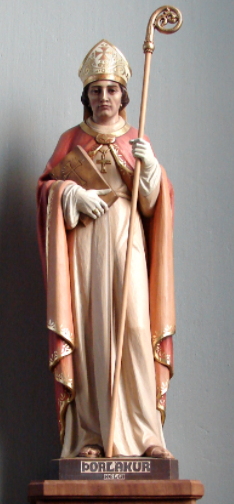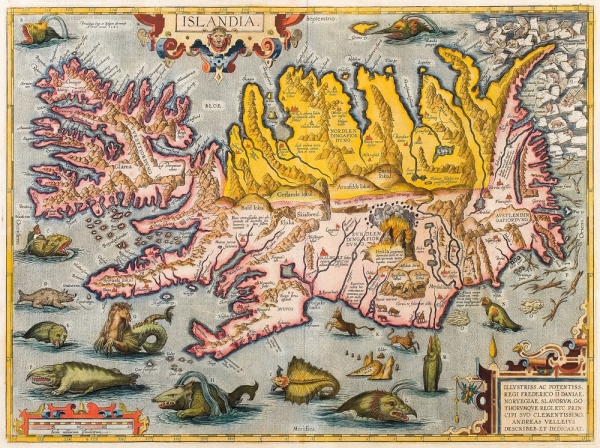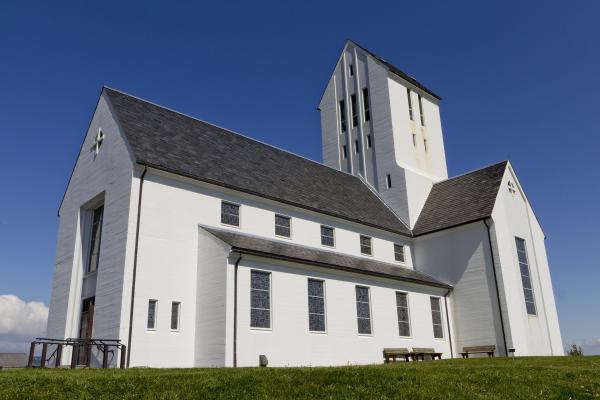Þorlákur Þórhallsson is an interesting figure. He is the only Icelander to have been canonized by the Catholic Church. He is also the only Catholic Saint who was recognized by Icelanders after the reformation.
Þorlákur was recognized as a saint by the Icelandic parliament in 1198, but was only canonized by the pope 800 years later. Throughout the centuries, even after the reformation had banned the belief in saints, Icelanders recognized him as the patron saint of the poor and the common folk.
Read more: December 23 is Þorláksmessa, the mass of St. Þorlákur, the patron saint of Iceland
When John Paul II canonized St Þorlákur in 1984 he recognized him as the patron saint of Iceland. In recent years some have been pushing to have him recognized as the patron saint of people with autism or autism spectrum disorders.
A poor, but intelligent and kind man

Þorlákur Þorláksson was born in 1133 to a poor farmer at Hlíðarendi farm in Fljótshlíð in South Iceland, near Seljalandsfoss waterfall. As a young man he quickly became recognized for his intelligence and kindness. He spent six years in England and France where he studied at seminaries. After returning to Iceland he served as a priest in South Iceland, where he in 1168 founded the first Augustinian monastery in Iceland.
In 1174 Þorlákur was elected the bishop of Skálholt bishopric by Alþingi. Skálholt bishopric covered West, South and East Iceland. North Iceland had its own bishopric, Hólar in Skagafjörður fjord. In 1178 the choice of Þorlákur as the bishop of Skálholt was confirmed by the archbishop of Niðarós.
Fought powerful chieftains
Some have speculated that the chiefs, who were busy fighting between themselves at this time, picked Þorlákur as a bishop because of his poor background: He had neither powerful nor wealthy family members to back him up. The 12th century in Iceland has been called the Age of Sturlungs, Sturlungaöld, after a decades long conflict between powerful and wealthy families. The chiefs reasoned that with a weak bishop the Church would not be a major threat to their power.

Þorlákur proved a bitter disappointment. Instead of being a weak and inefficient leaders he turned out to be one of the most energetic of the leaders of the Medieval church in Iceland. He whipped the Icelandic priesthood and church hierarchy into shape and enforced stricter religious observance, all the while expanding the wealth, power and influence of the church. Þorlákur attacked chiefs who had mistresses and reclaimed church lands powerful chiefs treated as their own.
On several occasions Þorlákur came close to being killed by powerful chiefs who disliked his meddling, but Þorlákur refused to back down.
An unofficial saint for 800 years
His piety and kindness made him extremely popular among the general public, and numerous stories of his kind deeds and piety circualted Iceland. Almost immediately after he died, in 1193 stories of his miracles started to emerge in different parts of Iceland. Some of these were said to have taken place during his life, while others took place after his death.
In 1198, five years after his death, Þorlákur's remains were moved back to the Cathedral at Skálholt. That same year Alþingi voted to recognize him as an offocial saint. Two mass days were dedicated to St Þorlákur in medieval times: Þorláksmessa in winter and Þorláksmessa in summer. July 20 was the summer feast of St Þorlákur, while the winter feast was on December 23. The winter feast is the only one still observed.

The story of his life and sainthood were then written down in Þorláks saga helga, The Saga of Bishop Thorlak. Þorlákssaga was written down in the first decade of the thirteenth century, and is one of the first of the bishops' sagas, a genre of hagiographic writings and Sagas which tell the story of contemporary events.
Þorlákur remained an unofficial saint for centuries, because it was only in the late 20th century he was finally recognized by the Catholic Church. One of the reasons Þorlákur was not canonized earlier was the cost of canonization. The Medieval church of Iceland simply couldn't afford the hefty fees charged by the papacy for canonization.
When John Paul II canonized Þorlákur on January 14 1984 he recognized him as the patron saint of Iceland. In recent years there has been a push by some to have Þorlákur recognized as the patron saint of autism and autism spectrum disorders.
widely observed as a saint by Icelandic Catholics during Medieval times, even if he was not formally recognized as a saint until 1984 when John Paul II canonized him and declared him a patron saint of Iceland.
Only Icelandic saint
Two years after Þorlákur was recognized as a saint by Alþingi the bishopric of Hólar in North Iceland lobbied successfully for its own saint. The first bishop of Hólar, Jón Ögmundarson was voted a saint by Alþingi in 1200. Then in 1315 a third bishop, Guðmundur Arason, was elevated to the role of a saint by then bishop of Hólar.
Neither Jón nor Guðmundur have been recognized by the Catholic Church.
Þorlákur Þórhallsson is an interesting figure. He is the only Icelander to have been canonized by the Catholic Church. He is also the only Catholic Saint who was recognized by Icelanders after the reformation.
Þorlákur was recognized as a saint by the Icelandic parliament in 1198, but was only canonized by the pope 800 years later. Throughout the centuries, even after the reformation had banned the belief in saints, Icelanders recognized him as the patron saint of the poor and the common folk.
Read more: December 23 is Þorláksmessa, the mass of St. Þorlákur, the patron saint of Iceland
When John Paul II canonized St Þorlákur in 1984 he recognized him as the patron saint of Iceland. In recent years some have been pushing to have him recognized as the patron saint of people with autism or autism spectrum disorders.
A poor, but intelligent and kind man

Þorlákur Þorláksson was born in 1133 to a poor farmer at Hlíðarendi farm in Fljótshlíð in South Iceland, near Seljalandsfoss waterfall. As a young man he quickly became recognized for his intelligence and kindness. He spent six years in England and France where he studied at seminaries. After returning to Iceland he served as a priest in South Iceland, where he in 1168 founded the first Augustinian monastery in Iceland.
In 1174 Þorlákur was elected the bishop of Skálholt bishopric by Alþingi. Skálholt bishopric covered West, South and East Iceland. North Iceland had its own bishopric, Hólar in Skagafjörður fjord. In 1178 the choice of Þorlákur as the bishop of Skálholt was confirmed by the archbishop of Niðarós.
Fought powerful chieftains
Some have speculated that the chiefs, who were busy fighting between themselves at this time, picked Þorlákur as a bishop because of his poor background: He had neither powerful nor wealthy family members to back him up. The 12th century in Iceland has been called the Age of Sturlungs, Sturlungaöld, after a decades long conflict between powerful and wealthy families. The chiefs reasoned that with a weak bishop the Church would not be a major threat to their power.

Þorlákur proved a bitter disappointment. Instead of being a weak and inefficient leaders he turned out to be one of the most energetic of the leaders of the Medieval church in Iceland. He whipped the Icelandic priesthood and church hierarchy into shape and enforced stricter religious observance, all the while expanding the wealth, power and influence of the church. Þorlákur attacked chiefs who had mistresses and reclaimed church lands powerful chiefs treated as their own.
On several occasions Þorlákur came close to being killed by powerful chiefs who disliked his meddling, but Þorlákur refused to back down.
An unofficial saint for 800 years
His piety and kindness made him extremely popular among the general public, and numerous stories of his kind deeds and piety circualted Iceland. Almost immediately after he died, in 1193 stories of his miracles started to emerge in different parts of Iceland. Some of these were said to have taken place during his life, while others took place after his death.
In 1198, five years after his death, Þorlákur's remains were moved back to the Cathedral at Skálholt. That same year Alþingi voted to recognize him as an offocial saint. Two mass days were dedicated to St Þorlákur in medieval times: Þorláksmessa in winter and Þorláksmessa in summer. July 20 was the summer feast of St Þorlákur, while the winter feast was on December 23. The winter feast is the only one still observed.

The story of his life and sainthood were then written down in Þorláks saga helga, The Saga of Bishop Thorlak. Þorlákssaga was written down in the first decade of the thirteenth century, and is one of the first of the bishops' sagas, a genre of hagiographic writings and Sagas which tell the story of contemporary events.
Þorlákur remained an unofficial saint for centuries, because it was only in the late 20th century he was finally recognized by the Catholic Church. One of the reasons Þorlákur was not canonized earlier was the cost of canonization. The Medieval church of Iceland simply couldn't afford the hefty fees charged by the papacy for canonization.
When John Paul II canonized Þorlákur on January 14 1984 he recognized him as the patron saint of Iceland. In recent years there has been a push by some to have Þorlákur recognized as the patron saint of autism and autism spectrum disorders.
widely observed as a saint by Icelandic Catholics during Medieval times, even if he was not formally recognized as a saint until 1984 when John Paul II canonized him and declared him a patron saint of Iceland.
Only Icelandic saint
Two years after Þorlákur was recognized as a saint by Alþingi the bishopric of Hólar in North Iceland lobbied successfully for its own saint. The first bishop of Hólar, Jón Ögmundarson was voted a saint by Alþingi in 1200. Then in 1315 a third bishop, Guðmundur Arason, was elevated to the role of a saint by then bishop of Hólar.
Neither Jón nor Guðmundur have been recognized by the Catholic Church.







